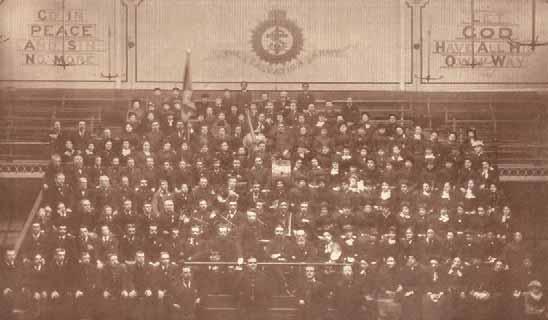
3 minute read
Reflection
A rink to the past
Clare Falvey traces the history and example of Regent Hall
Captain Baugh and Regent Hall Corps, 1882
REGENT Hall, aka ‘the Rink’, celebrated its 140th anniversary in June. In the Sunday morning meeting Commissioner Bill Cochrane set the congregation off wondering what the first ‘Rinkers’ were like.
This is answered by one of them: Bandsman George Manning, who wrote a sheaf of handwritten papers preserved by the International Heritage Centre. Now edited by Stephen Maw, The Romance of the Rink includes names, histories, anecdotes and activities during Manning’s soldiership, from 1882 to 1946.
Other early Rinkers appeared in War Cry reports from when William and Catherine Booth opened the corps on the weekend beginning 18 March 1882. The event entailed ‘glorious services’ and ‘vast crowds’, including a comic-singer, a prize-fighter, a grandmother with 240 convictions, one lady ‘saved out of the gutter’ and another, well-educated, ‘saved from her easy-chair’.
The list of corps officers in the back foyer of the hall begins with ‘1882–1883 Captain and Mrs William Baugh’. Their surname is usually pronounced ‘bore’, but nothing was boring about this captain, who’d just been sketched as a hero in the magazine Graphic (31 December 1881), after converting a gang of Whitechapel’s ‘Opposition Army’, including its leader, Charles Jeffries – a future commissioner and missioner to China.
The General saw fit to send Captain Baugh to the new Regent Hall – the defunct Princess Skating Rink, which Baugh described in the 10 May 1882 War Cry as ‘our West End fort’.
Two important activities of the Rink’s first decade were slum work and a significant change to officer training.
The slum work was initiated by one Rinker and consolidated by another. Schoolgirl Blanche Cox joined the corps at its opening. Defying parental plans for a Swiss finishing school, Blanche chose soldiership, sergeantship, then officership and teaching at the newly opened Clapton Training Home. She advertised this needful work in War Cry in late November 1884, introducing the ‘Cellar, Gutter and Garret Brigade’.
Their first long-term post was in an area known by the band, one of whose open-air locations was Hyde Park, the other a poverty-stricken area east of Oxford Street.
‘The nature of our work in Seven Dials among the poorest and most degraded has been little known to the public. We own a room there in which a few Training Home lasses (cadets) sleep; providing corporeal and spiritual works of mercy locally,’ wrote BB Cox THS (Training Home Staff), who supervised until he moved to Bombay (now Mumbai) in mid-1887.
The name of the slum ‘consolidator’ appears fifth on the list of corps officers – ‘1884 Captain Lydia Corbett’ – and she was in charge for just six months, returning to marry Staff-Captain James Cooke, as reported in the 16 December 1885 issue of War Cry.
In September 1886, the couple founded a new branch – the London Slum Work – with two important improvements. First, that officers would live in. Harriet Webb volunteered at Walworth, although her commissioning as first slum captain by Bramwell Booth took place at Regent Hall in early 1887. Second, that the slum post would engage with a nearby corps – thus Seven Dials with the Rink. The branches were amalgamated in February 1888 and held their larger gatherings at the corps.
The Cookes wrote detailed reports for the War Cry and All the World. Lydia’s devotion reflected a verse she once quoted: ‘In the slums and lanes and alleys,/ I will gladly fight for thee.’ James’s was embedded in his signature: ‘Yours, for the slums, Salvation.’ Their writing inspired Margaret Harkness’s In Darkest London, which featured the Rink, the slum communities and Captain Cooke.
The change in officer training in the late 1880s saw cadets no longer spend most of their time studying at Clapton Training Home but gain practical knowledge at large corps – called ‘depots’ and then ‘garrisons’ – before a final 10-day session at Clapton. Regent Hall engaged with the women’s garrison at 22 Nassau Street, a large red brick building with an imposing porch.
The early Rinkers excelled in fulfilling the Founders’ religious and social plans. Regent Hall today has the same aim in its mission: ‘We will be a visible, vibrant church bringing God’s transforming welcome to life in the world, in the heart of London and in people’s lives.’ Are we Salvationists today all equal to that?





